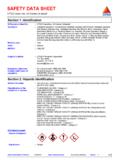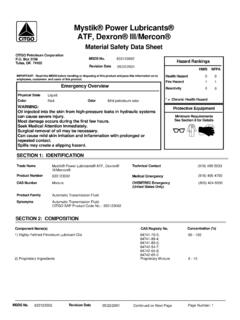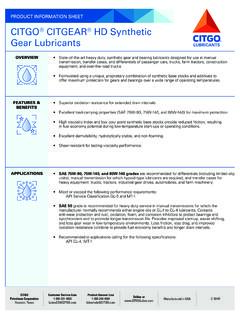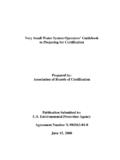Transcription of SAFETY DATA SHEET - CITGO
1 SAFETY DATA SHEET . transgard Multi-Purpose ATF. Section 1. Identification GHS product identifier : transgard Multi-Purpose ATF. Synonyms : Automatic Transmission Fluid; DEXRON lll / MERCON. Material uses : Transmission oil Code : 633135001. Supplier's details : CITGO Petroleum Corporation Box 4689. Houston, TX 77210. Emergency telephone : Technical Contact: (800) 248-4684. number (with hours of Medical Emergency: (832) 486-4700. operation) CHEMTREC Emergency: (800) 424-9300. (United States Only). Section 2. Hazards identification OSHA/HCS status : This material is considered hazardous by the OSHA Hazard Communication Standard (29 CFR ). Classification of the : EYE IRRITATION - Category 2B. substance or mixture SKIN SENSITIZATION - Category 1.
2 GHS label elements Hazard pictograms : Signal word : Warning Hazard statements : Causes eye irritation. May cause an allergic skin reaction. Injection of pressurized hydrocarbons can cause severe permanent tissue damage. Initial symptoms may be minor. Precautionary statements General : Read label before use. Avoid contact with eyes, skin and clothing. Thoroughly wash exposed areas and clothing with soap and water. IF IN EYES: Rinse cautiously with water for several minutes. IF SWALLOWED: Do not induce vomiting. If you feel unwell, seek medical attention and show the label when possible. Keep out of reach of children. If medical advice is needed, have product container or label at hand. Prevention : Wear protective gloves. Avoid breathing vapor.
3 Wash hands thoroughly after handling. Contaminated work clothing must not be allowed out of the workplace. Response : IF ON SKIN: Wash with plenty of soap and water. Wash contaminated clothing before reuse. If skin irritation or rash occurs: Get medical attention. IF IN EYES: Rinse cautiously with water for several minutes. Remove contact lenses, if present and easy to do. Continue rinsing. If eye irritation persists: Get medical attention. Storage : Store in a dry place and/or in closed container. Store in accordance with all local, regional, national and international regulations. Disposal : Dispose of contents and container in accordance with all local, regional, national and international regulations. Hazards not otherwise : Injection of petroleum hydrocarbons requires immediate medical attention.
4 Classified Date of issue/Date of revision : 4/30/2018 Date of previous issue : No previous validation Version :1 1/11. transgard Multi-Purpose ATF. Section 3. Composition/information on ingredients Substance/mixture : Mixture Other means of : Automatic Transmission Fluid; DEXRON lll / MERCON. identification CAS number/other identifiers CAS number : Not applicable. Ingredient name % CAS number Distillates (petroleum), hydrotreated heavy paraffinic 90 64742-54-7. Distillates (petroleum), hydrotreated light paraffinic 5 64742-55-8. Alkoxylated long chain alkyl amine **. * = Various ** = Mixture ** = Proprietary Any concentration shown as a range is to protect confidentiality or is due to process variation. There are no additional ingredients present which, within the current knowledge of the supplier and in the concentrations applicable, are classified as hazardous to health or the environment and hence require reporting in this section.
5 Occupational exposure limits, if available, are listed in Section 8. Section 4. First aid measures Description of necessary first aid measures Eye contact : Immediately flush eyes with plenty of water, occasionally lifting the upper and lower eyelids. Check for and remove any contact lenses. Continue to rinse for at least 10. minutes. If irritation persists, get medical attention. Inhalation : Remove victim to fresh air and keep at rest in a position comfortable for breathing. If not breathing, if breathing is irregular or if respiratory arrest occurs, provide artificial respiration or oxygen by trained personnel. It may be dangerous to the person providing aid to give mouth-to-mouth resuscitation. Get medical attention if adverse health effects persist or are severe.
6 If unconscious, place in recovery position and get medical attention immediately. Maintain an open airway. Loosen tight clothing such as a collar, tie, belt or waistband. Skin contact : Wash with plenty of soap and water. Remove contaminated clothing and shoes. Wash contaminated clothing thoroughly with water before removing it, or wear gloves. Continue to rinse for at least 10 minutes. Get medical attention. In the event of any complaints or symptoms, avoid further exposure. Wash clothing before reuse. Clean shoes thoroughly before reuse. Ingestion : Wash out mouth with water. Remove dentures if any. Remove victim to fresh air and keep at rest in a position comfortable for breathing. Do not induce vomiting unless directed to do so by medical personnel.
7 If vomiting occurs, the head should be kept low so that vomit does not enter the lungs. Get medical attention if adverse health effects persist or are severe. Never give anything by mouth to an unconscious person. If unconscious, place in recovery position and get medical attention immediately. Maintain an open airway. Loosen tight clothing such as a collar, tie, belt or waistband. Most important symptoms/effects, acute and delayed Potential acute health effects Eye contact : Causes eye irritation. Inhalation : No known significant effects or critical hazards. Skin contact : May cause an allergic skin reaction. Injection of pressurized hydrocarbons can cause severe permanent tissue damage. Initial symptoms may be minor. Ingestion : No known significant effects or critical hazards.
8 Over-exposure signs/symptoms Eye contact : Adverse symptoms may include the following: irritation watering redness Date of issue/Date of revision : 4/30/2018 Date of previous issue : No previous validation Version :1 2/11. transgard Multi-Purpose ATF. Section 4. First aid measures Inhalation : No specific data. Skin contact : Adverse symptoms may include the following: irritation redness Ingestion : No specific data. Indication of immediate medical attention and special treatment needed, if necessary Notes to physician : In the event of injection in underlying tissue, immediate treatment should include extensive incision, debridement and saline irrigation. Inadequate treatment can result in ischemia and gangrene. Early symptoms may be minimal.
9 Specific treatments : Treat symptomatically and supportively. Protection of first-aiders : No action shall be taken involving any personal risk or without suitable training . It may be dangerous to the person providing aid to give mouth-to-mouth resuscitation. Wash contaminated clothing thoroughly with water before removing it, or wear gloves. See toxicological information (Section 11). Section 5. Fire-fighting measures Extinguishing media Suitable extinguishing : Use an extinguishing agent suitable for the surrounding fire. media Unsuitable extinguishing : None known. media Specific hazards arising : In a fire or if heated, a pressure increase will occur and the container may burst. from the chemical Hazardous thermal : No specific data. decomposition products Special protective actions : Promptly isolate the scene by removing all persons from the vicinity of the incident if for fire-fighters there is a fire.
10 No action shall be taken involving any personal risk or without suitable training . Special protective : Fire-fighters should wear appropriate protective equipment and self-contained breathing equipment for fire-fighters apparatus (SCBA) with a full face-piece operated in positive pressure mode. Section 6. Accidental release measures Personal precautions, protective equipment and emergency procedures For non-emergency : No action shall be taken involving any personal risk or without suitable training . personnel Evacuate surrounding areas. Keep unnecessary and unprotected personnel from entering. Do not touch or walk through spilled material. Avoid breathing vapor or mist. Provide adequate ventilation. Wear appropriate respirator when ventilation is inadequate.















